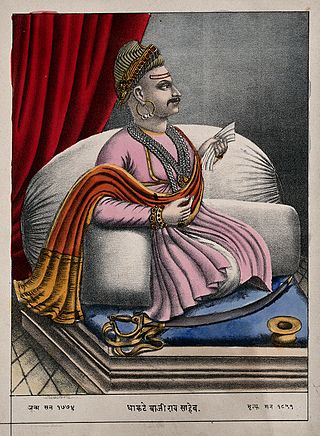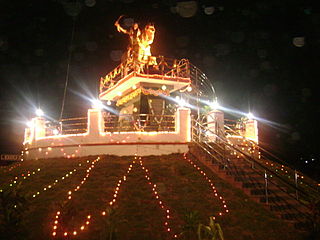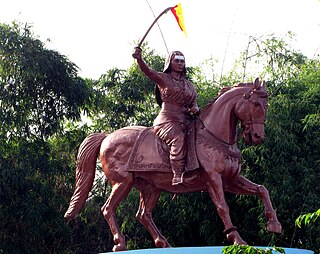
The Maratha Confederacy, also referred to as the Maratha Empire, was an early modern polity in the Indian subcontinent. It comprised the realms of the Peshwa and four major independent Maratha states often subordinate to the former. It was established in 1674 with the coronation of Shivaji as the Maratha Chhatrapati and recognised by Emperor Bahadur Shah I as a tributary state in 1707 following a prolonged rebellion. Following this, the Marathas continued to recognise the Mughal emperor as their nominal suzerain, similar to other contemporary Indian entities, though in practice, imperial politics at Delhi were largely influenced by the Marathas between 1737 and 1803.

The Wadiyar dynasty,(Kannada:[ oɖejɐru]) also referred to as the Wadiyars of Mysore, is a late-medieval Indian royal family of former maharajas of Mysore from the Urs clan originally based in Mysore city.

Belagavi district, formerly also known as Belgaum district, is a district in the state of Karnataka, India. The district is known as the sugar bowl of Karnataka with 150,000 hectares being used for commercial production. It has overtaken Mandya district in sugarcane production over the last decade. The city of Belgaum (Belagavi) is the district headquarters in Belagavi district. It houses the Second legislative building, where the Karnataka Legislature holds session once a year. The district is famous for its native sweet, Kunda. According to the 2011 Census of India, it has a population of 4,779,661, of which 24.03% live in urban areas, making it the second most populous district in Karnataka, after Bangalore Urban. The district has an area of 13,415 km2 (5,180 sq mi), making it the largest district in terms of size in Karnataka It is bounded by Kolhapur District and Sangli district of Maharashtra state on the west and north, on the northeast by Bijapur district, on the east by Bagalkot district, on the southeast by Gadag district, on the south by Dharwad and Uttara Kannada districts, and on the southwest by the state of Goa.

Mastani was the daughter of Chhatrasal Bundela and Ruhani Bai Begum. She was the second wife of the Maratha Peshwa Baji Rao I. Her relationship within the Maratha Brahmin family has been subject of both admiration and controversy and well adapted in Indian novels and cinema.

Baji Rao II was the 13th and the last Peshwa of the Maratha Confederacy. He governed from 1795 to 1818. He was installed as a puppet ruler by the Maratha nobles, whose growing power prompted him to flee his capital Poona and sign the Treaty of Bassein (1802) with the British. This resulted in the Second Anglo-Maratha War (1803–1805), in which the British emerged victorious and re-installed him as the titular Peshwa. In 1817, Baji Rao II joined the Third Anglo-Maratha War against the British, after they favoured the Gaekwad nobles in a revenue-sharing dispute. After suffering several battle defeats, the Peshwa surrendered to the British, and agreed to retire in return for an estate at Bithoor and an annual pension.

Kittur or Kitturu, historically known as Kittoor, is a town and a taluk in the Belagavi district of the Indian state of Karnataka. It was part of Bailhongal taluka but was declared as an independent taluka on 23 October 2012 by the Chief Minister of Karnataka on the inauguration of Kittur Utsav. It is 177th Taluk of Karnataka State. It is a place of historical importance because of the armed rebellion of Kittur Chennamma (1778–1829), Rani of the State of Kittur against the British East India Company, during which a British Commissioner, St John Thackeray was killed.

Kittur Chennamma was the Indian Queen of Kittur, a former princely state in present-day Karnataka. She led an armed resistance against the British East India Company, in defiance of the Paramountcy, in an attempt to retain control over her dominion. She defeated the Company in the first revolt, but died as a prisoner of war after the second rebellion. As one of the first and few female rulers to lead kittur forces against British colonisation, she continues to be remembered as a folk heroine in Karnataka, she is also an important symbol of the Indian independence movement.

Kittur is a fort located in the Karnataka state of India, it is the former capital of a minor principality as well as a major archaeological site.
Keladi Chennamma was queen regnant of Keladi Nayaka Kingdom in Karnataka between 1677 and 1696.

Nayakas of Keladi (1499–1763), also known as Nayakas of Bednore and Ikkeri Nayakas, were an Indian dynasty based in Keladi in present-day Shimoga district of Karnataka, India. They were an important ruling dynasty in post-medieval Karnataka. They initially ruled as a vassal of the famous Vijayanagar Empire. After the fall of the empire in 1565, they gained independence and ruled significant parts of Malnad region of the Western Ghats in present-day Karnataka, most areas in the coastal regions of Karnataka and the central plains along the Tungabhadra river. In 1763 AD, with their defeat to Hyder Ali, they were absorbed into the Kingdom of Mysore. They played an important part in the history of Karnataka, during a time of confusion and fragmentation that generally prevailed in South India after the fall of the Vijayanagar Empire. The Keladi rulers were of the Vokkaliga and Banajiga castes and were Veerashaivas by faith. The Haleri Kingdom that ruled over Coorg between 1600 A.D and 1834 A.D. was founded by a member of the Keladi family.

Belawadi Mallamma (1624–1678) was a warrior queen from the Belawadi province in present-day Karnataka, India. She is known for her leadership and resistance against invaders during a period of significant conflict in the region.

Belgaum Fort is in the city of Belgaum, in the Belgaum district, in Karnataka state, India. It was begun by Jaya Raya, also called Bichi Raja, an ally of the Ratta Dynasty, in the year 1204. It has undergone several renovations over the centuries under dynastic rulers of the region.

Dhondia Wagh was a military soldier and adventurer in 18th century India. He started his career in the service of Hyder Ali, the ruler of Mysore. During the Third Anglo-Mysore War, he deserted Ali's successor Tipu Sultan, and subsequently raided territories on the Maratha-Mysore border. After the Marathas forced him to retreat, he sought refuge from Tipu and converted to Islam, changing his name to Malik Jahan Khan. After Tipu's death in the Fourth Anglo-Mysore War, he raised a force comprising soldiers from the former Mysore Army, and took control of northern part of the Mysore Kingdom. He styled himself as Ubhaya-Lokadheeshwara. The British East India Company as well as the Maratha Peshwa sent armies to check his rising power. He was ultimately defeated and killed by a British force led by Arthur Wellesley.

The name Karnataka is derived from Karunadu, meaning 'lofty land' or 'high plateau', due to its location on the Deccan Plateau. The name can also mean 'land of black soil' in Kannada. There are other possible roots of the name. The recorded history of Karnataka goes back to the Ramayana and Mahabharata epics. The capital of "Vaali" and "Sugriva" referenced in the Ramayana is said to be Hampi. Karnataka is mentioned in the Mahabharata as "Karnata Desha"." Historically, the region was also called "Kuntala Rajya".

The following list includes a brief about the titles of nobility or orders of chivalry used by the Marathas of India and by the Marathis/Konkanis in general.

St John Thackeray (1778–1824) was a collector and political agent, who was working in south India for British East India Company during the 1820s.

Kitturu Chennamma is a 1961 Indian Kannada-language historical drama film directed and produced by B. R. Panthulu. It stars B. Saroja Devi as Kittur Chennamma, an Indian freedom fighter who led an armed rebellion against the British East India Company in 1824, and died in captivity in 1829. Dr. Rajkumar played the role of Raja Mallasarja whereas Raja Shankar played the role of his son.

The Bhatt Peshwa family earlier known as Bhat family is a prominent Indian Maratha Chitpavan Brahmin family who dominated India for around 100 years in the late 18th century and early 19th century. Most of the members in this family were the Peshwas in the Peshwa era of the Maratha Confederacy, and Peshwa later became their family name. During their regime, most of the Indian subcontinent was under their control. The last Peshwa, Baji Rao II, was defeated by the British East India Company in the Third Anglo-Maratha War in 1818. The territory was annexed to the British East India Company's Bombay Presidency, and he was pensioned.

Masjid-i-Ala is a mosque located inside the Srirangapatna Fort in Srirangapatna in Mandya District in Karnataka. It was built in 1786–87, during the rule of Tipu Sultan.
Niranjan Madhav also known as Niranjan Madhav Parasnis (1703-1790) was a diplomat and poet, who worked as Parasnis under Peshwa Bajirao I. He was sent on diplomatic assignments to Karnataka and Tamil Nadu by Bajirao I and Balaji Bajirao.





















